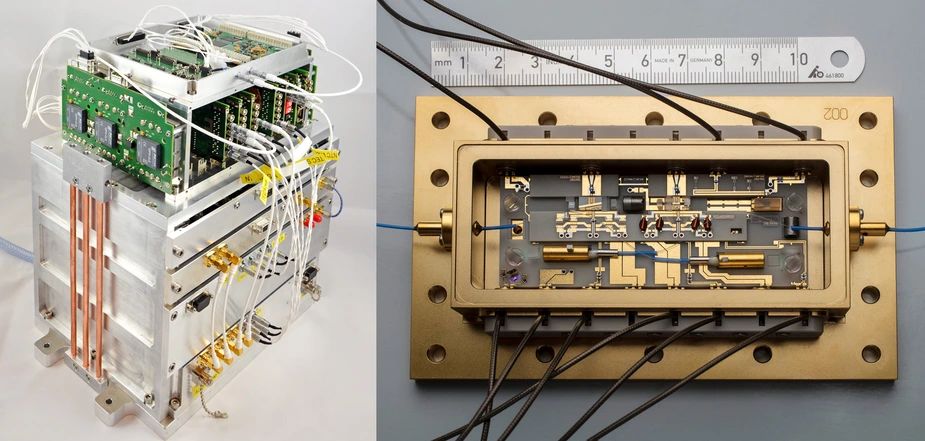Frequency-stable laser systems for space
JOKARUS experiment on sounding rocket successfully completed. Corner stone for laser ranging measurements with the highest precision and precursor for optical satellite navigation systems
For the first time a frequency reference based on molecular iodine was successfully demonstrated in space! What sounds a bit like science fiction is an important step towards laser interferometric distance measurements between satellites as well as for future global navigation satellite systems based on optical technologies. The frequency reference tests were carried out on 13 May on board the sounding rocket TEXUS54. The centerpiece of the payload, a compact laser system, which was primarily developed by HU Berlin and the Ferdinand-Braun-Institut, demonstrated its suitability for space.
In the JOKARUS experiment (German acronym for iodine comb resonator under weightlessness), an active optical frequency reference based on molecular iodine was qualified for the first time in space. The results are an important milestone towards using optical clocks in space. Such clocks are required, inter alia, for satellite-based navigation systems that provide data for accurate positioning. They are equally important for fundamental physics research, such as the detection of gravitational waves and measurements of the gravitational field of the Earth.
The experiment demonstrated the fully automated frequency stabilization of a frequency-doubled 1064 nm extended cavity diode laser (ECDL) on a molecular transition in iodine. Thanks to integrated software and algorithms, the laser system worked completely independently. For the sake of comparison, a frequency measurement with an optical frequency comb in the separate FOKUS II experiment was carried out during the same space flight.
Comprehensive know-how behind the compact diode laser system
The JOKARUS payload was developed and implemented under the direction of the HumboldtUniversität zu Berlin (HU Berlin) as part of the Joint Lab Laser Metrology. The lab, which is collectively operated by Ferdinand-Braun-Institut (FBH) and HU Berlin, combines the know-how of both institutions in the field of diode laser systems for space applications. A quasi-monolithic spectroscopy module was provided by the University of Bremen, the operating electronics came from Menlo Systems.
Centerpiece of the laser system is a micro-integrated ECDL MOPA that was developed and implemented by the FBH, with an ECDL acting as local oscillator (master oscillator, MO) and a ridge waveguide semiconductor amplifier as power amplifier (PA). The 1064 nm diode laser module is completely encapsulated in a 125 x 75 x 22.5 mm small package and delivers an optical power of 570 mW within the linewidth of the free-running laser of 26 kHz (FWHM, 1 ms measurement time). By means of a polarization-maintaining, optical single-mode fiber, the laser light is first divided into two paths, modulated, frequency-doubled and processed for Doppler-free saturation spectroscopy. Technology developments within JOKARUS are funded by the German Aerospace Center (DLR) and build on the earlier FOKUS, FOKUS reflight, KALEXUS and MAIUS missions.
Contact
Petra Immerz
Communications Manager
Ferdinand-Braun-Institut
Leibniz-Institut für Höchstfrequenztechnik
Gustav-Kirchhoff-Straße 4, 12489 Berlin
Tel. +49 30 6392-2626
Fax +49 30 6392-2602
Email petra.immerz(at)fbh-berlin.de
www.fbh-berlin.de
About the Joint Lab Laser Metrology at FBH
The Ferdinand-Braun-Institut and the Optical Metrology Group of the Mathematics and Natural Sciences Faculty of the Humboldt-Universitaet zu Berlin work closely together within the framework of the Joint Lab Laser Metrology to develop narrow-linewidth laser modules and laser systems for precision optical spectroscopy, specifically in the field and in space The cooperation brings together the expertise of semiconductor laser experts and quantum opticians so that the laser modules can be designed to meet the specific requirements of quantum optical experiments in harsh environments.
The Ferdinand-Braun-Institut, Leibniz-Institut fuer Hoechstfrequenztechnik (FBH) researches electronic and optical components, modules and systems based on compound semiconductors. These devices are key enablers that address the needs of today’s society in fields like communications, energy, health, and mobility. Specifically, FBH develops light sources from the visible to the ultra-violet spectral range: high-power diode lasers with excellent beam quality, UV light sources and hybrid laser systems.
